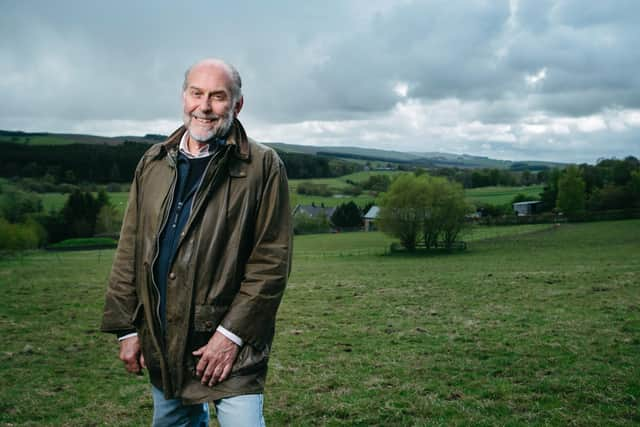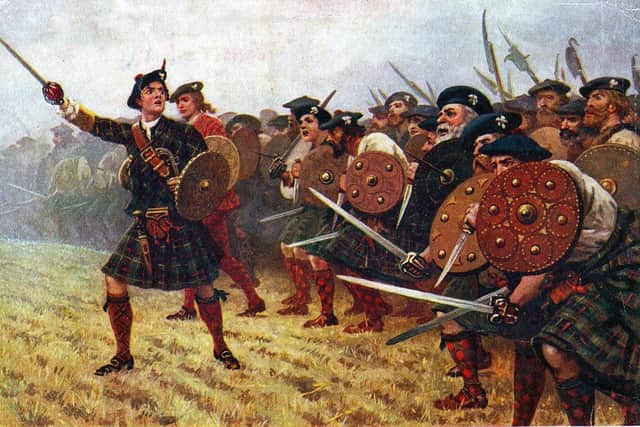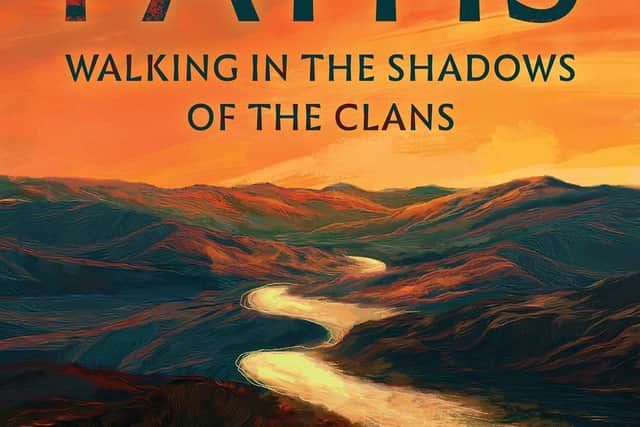Historian Alistair Moffat: ‘The Stuarts did not deserve the bravery of the clans’
Burned off by the sun rising over the North Sea, the haar lifted in moments. As quickly as the mist had rolled in over the cornfields before dawn on 21st September, 1745, the wisps of its grey curtain dispersed and revealed what the soldiers in the ranks of the government army thought at first was a black hedge.
Peering into the chill morning light, shading their eyes against the growing glow of the low sun, no one was certain what it was. But it did seem to some that the black hedge was moving.
Advertisement
Hide AdPlaces have spirits. Famously, on the islands of Iona and Lindisfarne the veil between worlds, between the past and the present, is gossamer thin. Where thousands of visitors now walk, saints walked before them and left behind an unmistakable legacy of sanctity, an atmosphere that can be intuited, something on the edge of understanding. I’d written a good deal about these wind-blown, whispering places where Columba and Cuthbert believed that Heaven was close and come to understand that going to where history happened could only enrich my sense of the past.


But I began to wonder that if holiness had left its impression on the map, might not echoes of other, darker moments be heard? What remained of the fury, the clamour and the bloodshed of war? Would I find any sense of how great and fatal events had played out in Scotland’s landscape, in places where armies had clashed? I had long been fascinated by the martial culture of the Highland clans, how they had fought, particularly against more modern armies of the 17th and 18th centuries.
How was it that with little more than bladed weapons, they had overcome the firepower of better-equipped enemies? Perhaps by following them on the war paths to where they fought, I might catch better sense of how and why history turned.
I spoke to many people as I walked on the old battlefields, and most were very helpful. At Falkirk Muir, I met someone who was even inspirational, full of kindly insights and happy to share them. But perhaps my most constant companions were never quite visible, although I never ceased to hear their whispers, and sometimes the distant echo of their war cries on the Highland winds. The warriors whose ghosts I followed on my journeys back into the darkness of the past were always with me.
Having walked where they charged, I was in awe of their physical courage and their unhesitating will to defend their beloved home-places. It was a privilege to walk beside such men.


The first of many journeys took me to East Lothian, to the site of the battle of Prestonpans, the first time the army of Prince Charles Edward Stuart confronted government forces. But before I recorded my own impression, I thought it made sense to set the scene.
Advertisement
Hide AdBehind where Prince Charles sat on horseback, protected by his lifeguards, out to the east, a pale dawn had begun to rise far out over the North Sea. But the mist still hid the small Highland army. Lord George Murray, probably the most capable general in the Jacobite high command, and the chiefs who led the clan regiments ordered their men to keep absolutely silent and with the front rank they crawled slowly through the stubble of the cornfield to get as close as possible to Cope’s lines. The black hedge had begun to move.
Then it suddenly began. The claideamh mor, the order to charge, came as the war pipes skirled, echoing through the morning air. Erupting from the mist-strewn stubble field like an army of spectres rising from the bowels of Hell, the Highlanders began to run towards the government army. And then they broke into an all-out charge. Howling like wolves, roaring their war cries, they came on very fast, closing quickly. Many paused to fire their muskets or pistols, immediately threw them down and raced towards the ranks of redcoats.
Advertisement
Hide AdRunning as quickly as they could, low to the ground, their small, round shields covering their heads and their broadswords drawn, the brave Camerons hit first, smashing into Cope’s troops on the right of his line, scattering them instantly. Leading from the front, Lord George Murray and the Duke of Perth ploughed on into the murderous melee, knocking aside bayonet thrusts with their targes, swinging their razor-sharp swords, furiously hacking and cutting, knocking men down, driving the redcoated soldiers backwards. Momentum was everything.


Prestonpans was a rout, a profound shock, a disaster for George II and his government. Many more men died in flight than in the battle ‘without firing, or being fired upon, and without drawing a sword’, according to a redcoat officer. The stubble of the cornfield was awash with blood and rang with the appalling agonies of the dying. Bladed weapons rarely kill quickly and the screams of the badly wounded rent the early morning air before the clansmen used their dirks and swords to put enemy soldiers out of their misery. Even across two and a half centuries, the shock felt by James Johnstone, a raw recruit, is palpable: "The field of battle presented a spectacle of horror, being covered with heads, legs, arms and mutilated bodies: for the killed all fell by the sword.”
Despite the remarkable victory at Prestonpans and the extraordinary success of the 1745 Jacobite Rising, it was the beginning of the end, the last time the Highland clans threatened the British state. But I wanted to understand how it was that these much-feared warriors had come to be in that position.
And so I began the story of War Paths with inter-clan warfare on the Isle of Lewis at the beginning of the 17th century and then walked on several battlefields where the Marquis of Montrose and the great MacDonald general, Alasdair macColla, had perfected the deadly techniques of the Highland charge. From these places, and particularly at Killiecrankie in 1689, I understood much more clearly how important the battleground was, the precise places where the Highlanders chose to fight. Sheriffmuir was a surprising, elegiac place where poor leadership in 1715 was more decisive than courage. The story ended, of course, at Culloden on 16th April, 1746.
Looking back over a century of rebellion, it occurred to me more than once that the Stuarts did not deserve the bravery of the clans and their immense blood sacrifice. As kings of England, Scotland and Ireland, they were a feckless, reckless dynasty whose actions and inactions doomed them to eventual and perhaps inevitable failure.
Charles I’s haughty obduracy ignited the War of the Three Kingdoms and cost him his head. James II and VII’s insistence on remaining a Catholic and trying to foist his religion on two overwhelmingly Protestant nations made his abdication and flight all too predictable. His exiled son’s diplomatic skills were negligible and his failure to raise the morale of the rebels of 1715 abject. But it is the self-pitying, embarrassing decline of Prince Charles that rankles most.
Advertisement
Hide AdThe bright hope that raised the standard at Glenfinnan faded fast in the fetid, petty politics of exile and failure in the crumbling palaces of Rome and Florence. The raw courage of the clans at Culloden and of countless other brave men was wasted on this lot, it seems to me.
More than that, there is something noble and profoundly attractive about the men who raised their claymores and raced across the heather. They were fighting for more than the restoration of a failed and useless dynasty. They charged headlong at their enemies to defend memory, to renew all their prowess, their ancient honour and their war-glory.
Advertisement
Hide AdWhen the clans recited their ancestry, summoned the Army of the Dead, at Culloden, it was as though the wind of history blew at their backs and carried their war cries clear across the snows of eternity and on to immortality. They were warriors to the very last.
War Paths: Walking in the Shadows of the Clans by Alistair Moffat is published by Birlinn on 3 August, £18.99, hardback
Comments
Want to join the conversation? Please or to comment on this article.